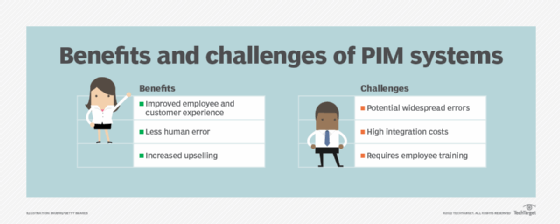
Getty Images/iStockphoto
3 benefits of product information management systems
PIM systems help retailers manage product information across channels. Key PIM system benefits include improved employee experience and reduced data entry errors.
Online and in-person retailers often struggle to manage product information -- especially those with extensive catalogs.
Organizations must provide accurate product information to customers and employees, such as sales and support teams, so they use software to manage this information. In particular, product information management (PIM) systems help retailers maintain accurate product catalogs. They can improve employee and customer experience (CX), reduce human error and increase upselling opportunities. However, these systems can also introduce challenges, such as widespread errors, high integration costs and user adoption difficulties.
Learn how PIM systems can help organizations manage product data, along with key implementation challenges retailers may face.
Benefits of PIM systems
PIM systems offer many benefits, such as improved employee and customer experience, reduced human error and increased upselling opportunities.
1. Improved employee and customer experience
PIM systems can create a single source of truth for product data, so employees such as sales agents, web designers and marketers can quickly access and retrieve the latest information. These systems ensure employees don't have to request or hunt for the latest data, which can improve the employee experience.
As PIM systems offer easy access to product information, they can also enhance customer service and sales efforts. For instance, sales and customer service agents can tap into a PIM system to quickly send product recommendations and details to customers and leads. This ability can reduce call hold times in contact centers, boost sales and improve overall CX.
2. Reduced human error
Retailers can integrate their PIM systems with external tools such as warehouse management systems and product lifecycle management systems to pull product specifications and inventory data into a central repository.
Organizations can also integrate their PIM systems with e-commerce platforms to ensure online shoppers have accurate product information. These integrations automate the data entry process, which can reduce the risk of human error.
3. Increased upsell opportunities
As PIM systems can classify and categorize products, they help retailers send customers relevant product recommendations based on past behavior. Product recommendations can also help sales agents identify upsell opportunities, such as additional products or add-ons, that customers can consider with their purchases.

Challenges of PIM systems
While PIM systems offer many advantages, they can also add complexity to the product information management process. These challenges include potential data entry errors, costly integrations and adoption challenges.
1. Potential data entry errors
Although a central repository for product information typically increases data accuracy, it can also allow one error to affect several departments. PIM systems have complex data input processes, and if a user incorrectly inputs data, the system may publish inaccurate information across channels.
2. Costly integration with other systems
To reduce the risk of data entry errors, many organizations look for ways to integrate their PIM systems with their ERP systems and e-commerce sites. Integrations require organizations to map their data and ensure data flows correctly between systems, which can take considerable time and resources to set up.
3. Adoption challenges
Organizations that implement PIM systems should change their internal policies that outline how employees should update and interact with product information. These organizations should also update their internal processes to ensure employees use the PIM system correctly. Workflow changes can create challenges, so organizations may need to offer employee training on the new system to increase the likelihood of user adoption.
PIM systems let retailers manage their product catalogs from a centralized repository and offer CX teams a trustworthy place to find product information. In addition to benefits, such as enhanced employee and customer experience, PIM systems can bring challenges, such as high integration costs and employee resistance. However, retailers can overcome most PIM system challenges with adequate planning and resources in place.








